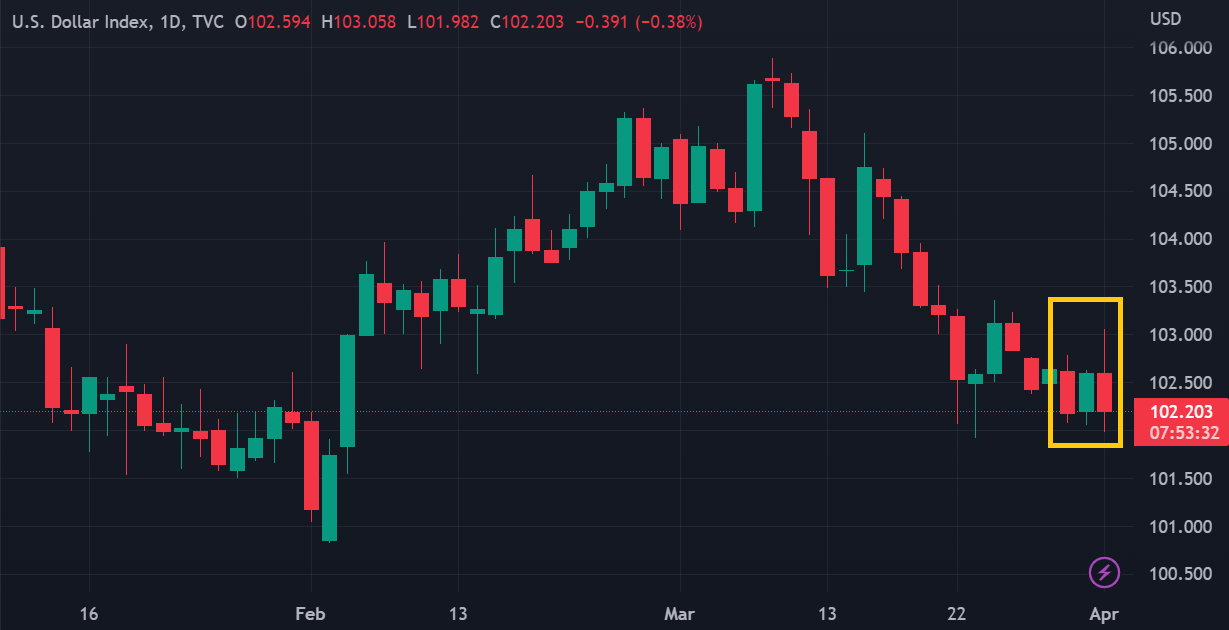After soaring on the back of the sudden OPEC decision, the US dollar exchange rate plummeted along with weakening expectations of interest rates.
The US dollar index (DXY) briefly soared to a daily high above the 103.00 thresholds in the Asian session but immediately fell back to the 102.00 range. As of the beginning of the New York session on Monday (April 3), the Dixie was still stuck in a narrow range near its daily low. Fluctuations occurred due to the ebb and flow of expectations for the Fed's interest rates.

Several market observers believe that the strength of the US dollar at the beginning of the month is related to the surprising decision of OPEC+. The world's largest cartel suddenly decided to cut oil output quotas by more than one million barrels per day, causing oil prices to soar more than 6 percent quickly. Market volatility like this tends to benefit the US dollar exchange rate.
Rising oil prices can boost inflation, thus increasing the chances of the Fed raising interest rates. Due to these speculations, US Treasury 10Y bond yields surged to above 3.5000% again.
Unfortunately, speculation of rising inflation and interest rates did not last long. At the time of writing, US Treasury 10Y yields have dropped back to around 3.4100%.
The US dollar exchange rate also weakened. This is because oil prices and other energy commodities do not directly affect core inflation, the main policy reference for central banks worldwide.
Karl Schamotta, chief market strategist at Corpay in Toronto said that after the oil news, markets have pivoted back toward the deeper disinflationary fundamentals that are likely to drive the monetary policy outlook. "Central banks are thought likely to stay focused on growth, employment and core inflation measures, which reflect energy prices at a long lag, so market-implied odds on rate cuts are reverting toward pre-production cut levels. Rate differentials are correspondingly turning back against the dollar."
The release of Manufacturing PMI data dealt a second blow to the USD. ISM reported that US manufacturing activity in March 2023 plunged deeper into contraction territory. The PMI score dropped from 47.7 to 46.3 (consensus estimate 47.5), recording its lowest level in the past 21 months.
The details of the ISM report depict a bleak situation overall. The price sub-index fell from 51.3 to 49.2, indicating a significant decline in inflation pressure in the US manufacturing sector. The employment and new orders sub-indices also weakened. These figures made market participants more pessimistic about the prospects of US interest rates.

 Dedicated FREE FOREX VPS
Dedicated FREE FOREX VPS Free FOREX Virtual Private Server
Free FOREX Virtual Private Server MT4 Demo Contest, Get $500
MT4 Demo Contest, Get $500 Sign Up for an Account, Claim 60% Deposit Bonus
Sign Up for an Account, Claim 60% Deposit Bonus Free MT4/MT5 VPS 2024
Free MT4/MT5 VPS 2024 Send E-mail and Get Free Merchandise
Send E-mail and Get Free Merchandise $1K Refer a Friend Bonus for Pepperstone Pro clients
$1K Refer a Friend Bonus for Pepperstone Pro clients Maximize Your Earnings with 100% Deposit bonus
Maximize Your Earnings with 100% Deposit bonus Trade to Win, $5,000 Monthly Demo Contest
Trade to Win, $5,000 Monthly Demo Contest Claim 30% + 15% Deposit Bonus from LiteFinance
Claim 30% + 15% Deposit Bonus from LiteFinance






